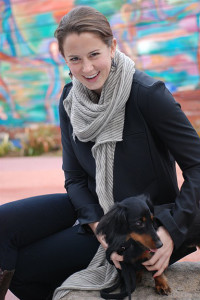 Elizabeth Schmidt graduated from Middlebury College in Vermont and ambitiously entered the Teach for America program in a world quite different than the one she grew up in – South Central, Los Angeles. One of the first assignments she gave her tenth graders was a research paper, but when the due date rolled around only %5 of the students turned it in. Instead of becoming upset, Schmidt changed her approach. She reassigned the paper, but with a topic that was relevant to her students. The students were asked to to research any after-school or summer program within the greater Los Angeles community, and to write a compelling argument as to why they should attend. And this time the reward was much greater than a grade: the top seven essays would win attendance to the program. The idea worked and 75% of the students turned in their paper on time. Schmidt ran a marathon to raise money for tuition, and Wishbone was born.
Elizabeth Schmidt graduated from Middlebury College in Vermont and ambitiously entered the Teach for America program in a world quite different than the one she grew up in – South Central, Los Angeles. One of the first assignments she gave her tenth graders was a research paper, but when the due date rolled around only %5 of the students turned it in. Instead of becoming upset, Schmidt changed her approach. She reassigned the paper, but with a topic that was relevant to her students. The students were asked to to research any after-school or summer program within the greater Los Angeles community, and to write a compelling argument as to why they should attend. And this time the reward was much greater than a grade: the top seven essays would win attendance to the program. The idea worked and 75% of the students turned in their paper on time. Schmidt ran a marathon to raise money for tuition, and Wishbone was born.
According to the founder herself, “The main principle behind Wishbone is in teaching students to help themselves, empowering them through the discovery of authentic and independent passions.” The goal is twofold: 1. to expose the student to new and diverse communities, and to help him or her think about their future and how to pursue it, and 2. give students a drive to graduate high school and move on to college or a professional field. Because students find their program and apply for the Wishbone grant themselves, they are able to take pride in their work and start the process of working towards Wishbones goals, as well as ensure that the program they choose matches their passions and talents.
Schmidt is unable to run the amount of marathons it would take to raise money for all of the students Wishbone supports today. Instead, donations work similar to crowdfunding. Donor’s are able to watch a one minute pitch from students and learn their story. They can then either grant a wish fully or make a partial donation – a minimum of $25. Donors are then able to track their students story. This accountability can add new motivation for students.
There are several aspects of this organization I find admirable. First, Schmidt did not become frustrated or passive about the problems she and these children faced. Instead, she chose to make schoolwork relevant to students’ experiences and give them hope for something more than they saw. Second, Wishbone is not just a handout. The students that receive scholarships do so because they put in the work to find and apply for the programs. Not only this, they encourage all students to constantly set goals for the future. Lastly, creating the sort of quality media to crowdfund Wishbone’s products is essential. Their website, videos, and blog are beautiful and functional. Donor’s ability to follow the story after they have contributed creates a relationship with the organization that keeps them coming back.
The first seven students to win Schmidt’s contest all graduated from high school and continued on to college, and in its first year of existence Wishbone sent 150 students to programs in Los Angeles, New York City, and San Francisco. Schmidt still runs Wishbone and works with students, and her team has expanded to several advisers and partners. I would encourage you to check out their website and watch some of their incredible videos.
